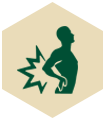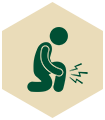- No products in the cart.
Chronic pain is not only a major healthcare problem worldwide, but it also has a negative impact on a person’s quality of life, everyday activities and social functions.1
While acute pain is a normal sensation triggered in the nervous system to alert you to possible injury and the need to take care of yourself, chronic pain is different. Chronic pain persists. Pain signals keep firing in the nervous system for weeks, months, even years.
There may have been an initial mishap — sprained back, serious infection, or there may be an ongoing cause of pain — arthritis, cancer, ear infection. Some people suffer chronic pain in the absence of any past injury or evidence of body damage. Many chronic pain conditions impact older adults. Common chronic pain complaints include headache, low back pain, cancer pain, arthritis pain, neurogenic pain (pain resulting from damage to the peripheral nerves or to the central nervous system itself).
A market research report indicates that more than 1.5 billion people worldwide suffer from chronic pain and about 3 to 4.5 percent of the global population suffers from neuropathic pain, with incidence rate increasing in conjunction with age.2 The prevalence of chronic pain among Asian adults’ ranges from 7.1% (Malaysia) to 61% (Cambodia and Northern Iraq), whereas among the Asian geriatric population, the prevalence is even higher and ranges from 42% to 90.8%.3
Chronic Pain impairs everyday activities, social functions, and quality of life. Pan-European and Danish studies found:
- Between half and two-thirds were less able or unable to exercise, enjoy normal sleep, perform household chores, attend social activities, drive a car, walk or have sexual relations.
- One in four reported that relationships with family and friends were strained or broken
- One in three were less able or unable to maintain an independent lifestyle.
- One in five had depression because of pain.
- 17% suffered so badly that some days they wanted to die.
- 39% felt their chronic pain was inadequately managed. In such cases, half felt their doctor did not view their pain as a problem.
Pain Relief Without Drugs & Surgery
Avazzia BESTTM devices are hand-held, battery-operated, non-invasive microcurrent electro-stimulation medical device. The microcurrent interactive feedback and electro-stimulation technology gently stimulates the body’s natural resources to resolve pain, not just mask it.
Avazzia BESTTM (Bio-Electric Stimulation Technology) helps redress an underlying physiological dysfunction as well as reducing its symptoms and features non-invasive neuromodulation (changing signal of nerves). There is no habituation, as the electrical properties of the tissue changes with each signal applied by the device. This concept of biofeedback is dependent on tissue conductivity and independent of human brain process.
Avazzia BESTTM devices generate microcurrent and pulsed high voltage to stimulate C-fiber (pain fiber) which are embedded in most tissues as well as the Central Nervous System. C-fibers (which is composed of 85% of all nerves found in the body) will then transmit these impulses from surface of skin to the brain where cascades of neuropeptide (nitric oxide, endorphins, etc.) will be released into the bloodstream.
- Nitric oxide causes vascular dilation and thereby increases blood circulation. This is critical to wound healing, reduction of edema, and treatment of diabetic neuropathy.
- Endorphins are the body’s natural pain management chemicals.4,5
- Neuropeptides are the body’s regulatory elements that promote accelerated healing.6
In terms of Pain Management, Cortisol and TNF-α levels are reduced.7 It has been postulated that Substance-P levels are also reduced.
It has been stated that Inflammation is the cause behind most diseases and inflammation indications are Pain, Swelling, Heat, Redness and Limited movement Range. Electrodes on the BESTTM device electrodes (onboard or through accessories) can detect via tissue conductivity feedback the acupuncture or electron deficient (inflammation) sump points when moving the device over the skin. These areas may be injured or diseased tissue or may be associated with an organ or corresponding body system. By placing the BESTTM electrodes at a correct spot for treatment, equilibrium between tissues and organs is restored, and the redox (reduction oxidation) potential of the body is recharged. Hence, with Avazzia BESTTM devices, inflammation is treated first by diagnosing and treating trigger points (inflammation points) before localised current using conductive pads is passed through the area. Using BESTTM, source of pain and not point of pain is treated.
For many patients, the results at times seem “miraculous”:
- Avazzia BESTTM products quickly provide relief of chronic and other pains.8
- The pain relief is long-lasting, up to 12 hours, and frequently longer.
- Treatment near and over scars improves the look, texture, and tone of scars.
- Scars, including keloid scars, flatten and colour improves with repeated treatment.
Avazzia BESTTM devices are USFDA-cleared for:
Symptomatic relief and management of chronic, intractable pain, and adjunctive treatment in the management of post-surgical and post-traumatic pain.
Temporary relief of pain associated with sore and aching muscles in the shoulder, waist, back, back of the neck, upper extremities (arm), and lower extremities (leg) due to strain from exercise or normal household work activities.
Avazzia BESTTM devices work to relieve CHRONIC & ACUTE pain
Without DRUGS or SURGERY

Chronic Back Pain and intractable pain

Pain Associated With Sports Such As Foot, Tendon & Calf Pain

Plantar Fasciitis and Heel Spurs

Aches & Pains Caused By Repetitive Injuries Such As Carpal Tunnel Syndrome

Pain Associated With Physical Therapy, Especially After Surgery For Knee or Hip Replacement

Back Pain Associated With Travel or Work
A survey conducted by Avazzia, Inc. resulted in respondents perceiving that Avazzia BESTTM devices are effective and a safe adjunctive treatment for alleviation of pain and have no side effects.
After using BESTTM devices for treatment, 100 percent of the forty-one (41) participants reported improved range of movement. Participants also reported:
A published Wound study conducted in Hospital Kuala Lumpur, Malaysia, in 2017 showed that eleven participants were pain-free at the end of the four-week period and fifty-nine participants experienced 50 percent and above reduction in pain.
Nair, H.K. Microcurrent as an adjunct therapy to accelerate chronic wound healing and reduce patient pain, Journal of Wound Care, 27(5), 296-306, May 2018
Citations:
- International Association for the Study of Pain: Unrelieved pain is a major global healthcare problem.
- Global Industry Analysts, Inc. Report, http://www.prweb.com/pdfdownload/8052240.pdf.
- A Systematic Review of the Prevalence and Measurement of Chronic Pain in Asian Adults Mohamed Zaki L.R., Hairi N.N. (2015) Pain Management Nursing, 16 (3), pp. 440-452.
- “Human Bodies Make Their Own Morphine” Christine Dell’Amore, National Geographic News,
- Anette Kjellgren, 2003, The experience of floatation REST (restricted environmental stimulation technique), subjective stress and pain, Goteborg University Sweden, Kjellgren A, Sundequist U et al.. “Effects of flotation-REST on muscle tension pain”. Pain Research and Management 6 (4): 181–9
- Wolcott LE, Wheeler PC, Hardwicke HM, and Rowley BA (1969). “Accelerated healing of skin ulcer by electrotherapy: preliminary clinical results”. Southern Medical Journal 62 (7): 795–801.PMID 5306004.
- Ng MM, Avazzia Biofeedback Electrostimulation Therapy (Avazzia BEST): Its Effect on Changes in Pain Biomarkers on Chronic Neuropathic Pain: A Prospective Randomised Controlled Trial. In Press 2014.
- Spreier J, (2012), “Efficacy of Avazzia BEST Microcurrent Stimulation Device”, Avazzia, Inc., MKT-121214-03




